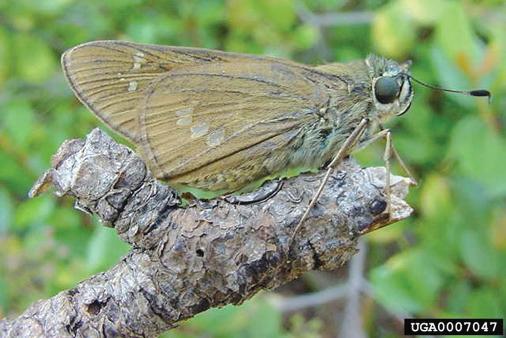PEST 411
Larger canna leafroller
A major insect pest of canna lily by Shimat V. Joseph, Assistant Professor, Department of Entomology, University of Georgia The larger canna leafroller (LCLR),
Herbert A. 'Joe' Pase III, Texas A&M Forest Service, Bugwood.org,
Calpodes ethlius (Stoll), is a major pest of canna lily in Georgia. Native to Mexico, Central America, and the northern part of the South American continent, this pest is well established in the southern states, including Georgia. This pest is also referred to as the Brazilian skipper, the canna butterfly, or the arrowroot butterfly.
Biology The LCLR adult is a medium-sized, Fig. 1. Larger canna leaf roller butterfly. brownish skipper butterfly (Fig. 1). The females (22-27 mm in length) are larger than the males (23 to 24 mm). The first pair of wings has five clear spots and yellow-colored hairs on the lower margin. The second pair of wings has three clear spots.
UAC MAGAZINE | WINTER 2021
Charles T. and John R. Bryson, Bugwood.org
18
Similar to other skipper butterflies, LCLRs are erratic and fast fliers and consume nectar from the flowers. In Georgia, adults start laying eggs in midMay and undergo multiple generations through the summer. The attacks on plants persistently continue until temperatures cool down in the fall. The eggs are about 1 mm in diameter and are visible by the naked eye (Fig. 2). Pale green colored eggs are laid singly on the upper and
lower leaf surface of canna. Sometimes, several eggs can be found on a single leaf. A day after laying, the eggs turn a pinkish color. A few days later, the eggs hatch.
Feeding They initially feed on the leaf margin creating a leaf flap (Fig. 3A). Then the larva ties the leaf flap with the rest of the leaf using silken strands. A few days later, the larva systematically rolls the leaf by tying from a smaller roll to rolling the entire leaf (Fig. 3B and C). The caterpillar feeds within the roll and pushes out the frass pellets (excrements) from the leaf rolls. The leaf roll provides shelter and protection from the sun and natural enemies.
Development The greenish, naked, or transparent larva has a distinctively large head capsule (Fig. 4). Initially, the head is black but turns into an orange color with black triangular marks in the later stages (fourth and fifth stage larva) of larval development (Fig. 4C). Because the caterpillar feeds on green leaves, the color of the caterpillar appears green. The larvae molt five times before transforming to pale green pupae within the leaf roll.
Host plants and damage LCLR mostly attacks plant species within the Cannaceae family. The only other family where LCLR was found is West Indian arrowroot, Maranta arundinacea L. The leaf rolling can cause severe damage to canna plants as most of the leaves are rolled. Any new shoots that emerge of the rhizome are severely attacked, and plants hardly produce any flowers if not managed. LCLR also feed on the emerging flowers (Fig. 3D). The entire plant appears completely beaten and battered (Fig. 5).


















